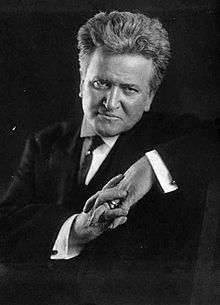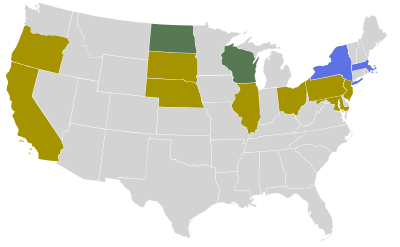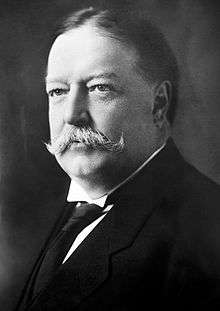Republican Party presidential primaries, 1912
| | |||||||||||||||||||||||||||||||||||
| |||||||||||||||||||||||||||||||||||
| |||||||||||||||||||||||||||||||||||
|
| |||||||||||||||||||||||||||||||||||
| Results by state
Taft
Roosevelt
La Follette
No Primary | |||||||||||||||||||||||||||||||||||
| |||||||||||||||||||||||||||||||||||
The 1912 Republican presidential primaries were the selection process by which the voters of the Republican Party chose its nominee for President of the United States in the 1912 presidential election. Incumbent President William Howard Taft was chosen as the party's nominee through a series of primaries and caucuses culminating in the 1912 Republican National Convention.[1]
Candidates
Nominee
Withdrew during Convention
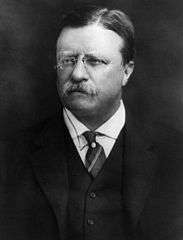
Former President
Theodore Roosevelt
from New York
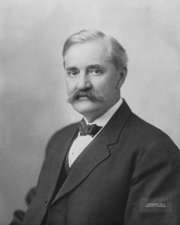
Campaign
Background
During his first year in office, President Taft set in motion a series of events leading to a split in the Republican Party. By the middle of 1909, progressive Republicans had started accusing Taft of granting the pro-business wing of the party near total leeway on the filling of political positions.
The off-year elections of 1909 were to a large degree fought on local issues relating to reform, and they were mostly a draw between the two parties. In New York State, Governor Charles E. Hughes asked the legislature to pass a bill providing for primary elections for each state office except for that of presidential electors. The proposal for primaries became the major issue in the state legislative elections, in which the Democrats gained five seats. Gubernatorial races were retained by the Republicans in Rhode Island and Massachusetts, though in the latter state bolting reformers almost delivered the race to the Democrats. Reformers won control of the mayoralty of Indianapolis, but "machine" candidates won in New York City, Buffalo, Albany, and Cincinnati.
The following year (1910), former President Theodore Roosevelt and sitting Vice President James S. Sherman both sought to be the temporary chairman of the New York State Republican convention. Sherman's victory there was the first sign that the progressive Republicans faced major challenges if they wanted to work within the party. The rift spilled over into Michigan, where local conventions in the summer became polarized over Roosevelt.
Intra-party tension cost the Republicans dearly in the midterm elections of 1910. Their major defeat was in Congress. In the Senate, the Democrats took ten seats from the Republicans, cutting the margin in half. The Democrats took control of the U.S. House, defeating 45 incumbent Republicans to move from a 47-vote deficit to a majority of 67. In gubernatorial races, the Democrats took Idaho, Maine, and New Jersey while the Republicans took Nebraska, Nevada, and Tennessee. An Independent was elected in Wyoming, taking that seat out of the Republican column.
A major goal of the progressives in 1911 was a push for primaries. By July 12, at least six states had passed legislation for delegates to the national convention to be chosen in primaries: North Dakota, Wisconsin, Nebraska, Oregon, New Jersey, and Florida. Progressive Republicans increased their calls for primaries following the off-year election of 1911. On November 11, leading Progressives contacted all Republican state chairmen and asked them to provide for selection of delegates to the upcoming Republican National Convention by primaries. Senator Albert B. Cummins, a moderate progressive from Iowa, endorsed the idea and asked Republicans to stop pressing him to run for president.
Campaign
During the last two months of 1911, Progressive Republican leaders questioned how to proceed for the spring primaries. LaFollette was gaining endorsements from progressives around the nation, but he was perceived to be too radical for the party. One by one, leading progressives began to come out for President Roosevelt. On November 21, Roosevelt's name was officially entered into a primary, that of Nebraska. Roosevelt finally announced on December 23 that he would accept the nomination if granted to him, but that he would not campaign for it. In February 1912, Roosevelt officially began his campaign for the nomination.
The jockeying by Taft, Roosevelt, and LaFollette began in state conventions and continued through the primary season. By the time of the first presidential preference primary, held in North Dakota on March 19, Taft was leading in the delegate count with 127 to 10 for his challengers. These delegates had been chosen in conventions. Voters who braved the cold rain in North Dakota on primary day handed the first official presidential primary to LaFollette. The campaign there was almost exclusively a Roosevelt vs. LaFollette race; LaFollette ended up with 57% to 40% for Roosevelt and 3% for Taft. Roosevelt asserted that loss was due to Democrats who voted for LaFollette to embarrass his candidacy. President Taft's first major victory came in New York's primary on March 26. Just before the vote, the New York Times reported that Taft had won 134 out of the 170 delegates chosen nationwide. New York Republicans voted overwhelmingly for Taft, by roughly a 2-to-1 margin; New York City gave Taft nearly 70% of the vote there. It was a stunning repudiation of Roosevelt in his home state and his second loss in the first two presidential primaries.
Roosevelt changed his strategy following his New York debacle. He issued an ultimatum to Republicans on March 28 to nominate him, or he would run as an independent. With local conventions being held nearly on a daily basis, Roosevelt was falling further behind in the delegate counts. LaFollette scored another major victory on April 2 when he won his home state of Wisconsin. He defeated Taft by a 73-26% margin; Roosevelt missed the filing deadline but received some write-in votes. Roosevelt's fortunes began to change with the Illinois primary on April 9. In his first primary victory, Roosevelt won 61% of the vote to Taft 29% and LaFollette 10%. Roosevelt won every county, though Taft won some Congressional Districts in Chicago.
In the two weeks following the Illinois primary, Roosevelt won three states. He defeated Taft by a 60-40% margin in Pennsylvania on April 13. Nebraska and Oregon voted on April 19, going to Roosevelt with 59% and 40% respectively. Taft ended the month with a 50-48% win in Massachusetts. However, due to the Massachusetts ballot offering a presidential preference separate from the delegate vote, Roosevelt won more delegates even though he placed second. By the end of the month, Roosevelt was leading in delegates chosen in primaries with 179 to 108 for Taft and 36 for LaFollette. Due to the fact that just 14 states held primaries, Taft had 428 delegates overall while Roosevelt had 204 and LaFollette had 36.
Five states voted in the final four weeks of the primary season, and Roosevelt won all five states. He won Maryland 53-47 over Taft. In California, Roosevelt received 55% to Taft's 27% and LaFollette's 18%. The major shock of the primary season was Roosevelt's 55-40% defeat of Taft in his home state of Ohio on May 21. One week later, Roosevelt won New Jersey, 56-41%. The primary season wrapped up with South Dakota, where Roosevelt won with 55%.
Altogether, Roosevelt won 290 delegates in the primaries to 124 for Taft and 36 for LaFollette. Including delegates chosen in party conventions however, Taft had a 566-466 margin, placing him over the 540 needed for nomination.[2]
Results
| Date | State | William Taft | Theodore Roosevelt | Robert La Follette |
|---|---|---|---|---|
| March 19 | North Dakota | 3.1% | 39.7% | 57.2% |
| March 26 | New York | 66.43% | 33.57% | 0% |
| April 2 | Wisconsin | 26.1% | 0.3% | 73.2% |
| April 9 | Illinois | 29.2% | 61.1% | 9.8% |
| April 13 | Pennsylvania | 40.3% | 59.7% | 0% |
| April 19 | Nebraska | 21.5% | 58.7% | 17.1% |
| April 19 | Oregon | 28.5% | 40.2% | 31.3% |
| April 30 | Massachusetts | 50.4% | 48.3% | 1.2% |
| May 5 | Maryland | 47.2% | 52.8% | 0% |
| May 14 | California | 27.3% | 54.6% | 18.1% |
| May 21 | Ohio | 39.5% | 55.3% | 5.2% |
| May 28 | New Jersey | 40.5% | 56.3% | 3.2% |
| June 4 | South Dakota | 28.9% | 55.2% | 15.9% |
See also
References
- ↑ "Guide to U.S. Elections - Google Books". Books.google.com. 2016-02-19. Retrieved 2016-02-19.
- ↑ "TAFT 566 - ROOSEVELT 466. - Present Line-Up of Instructed and Pledged Delegates With All the Contests Decided.". New York Times. 1912-06-16. Retrieved 2016-02-24.

